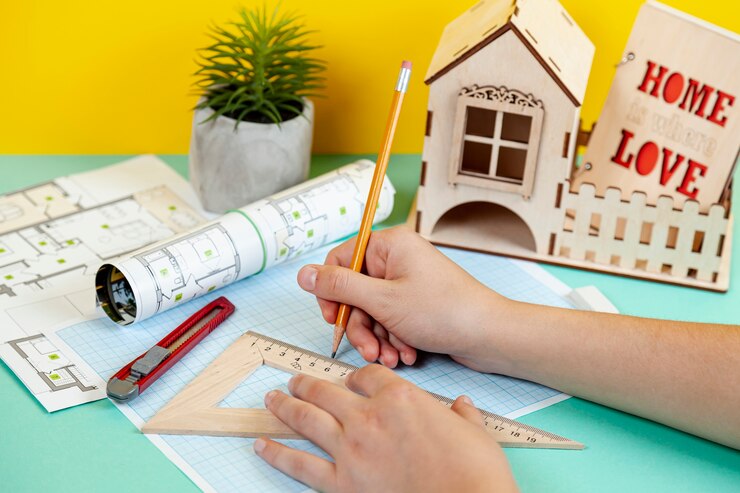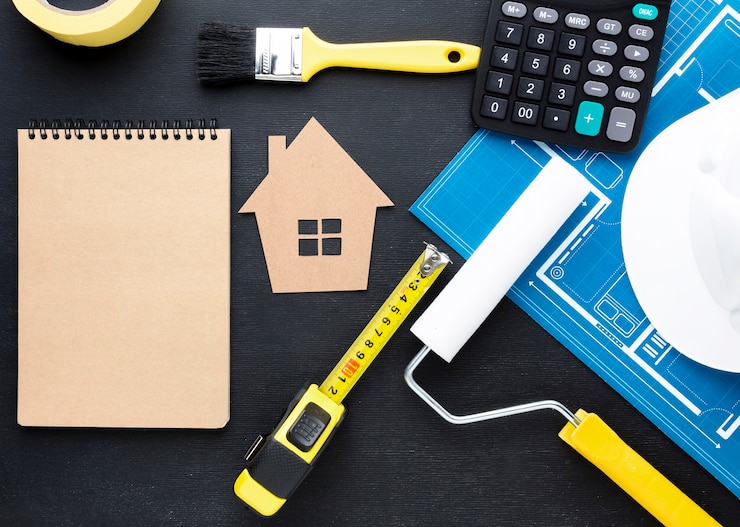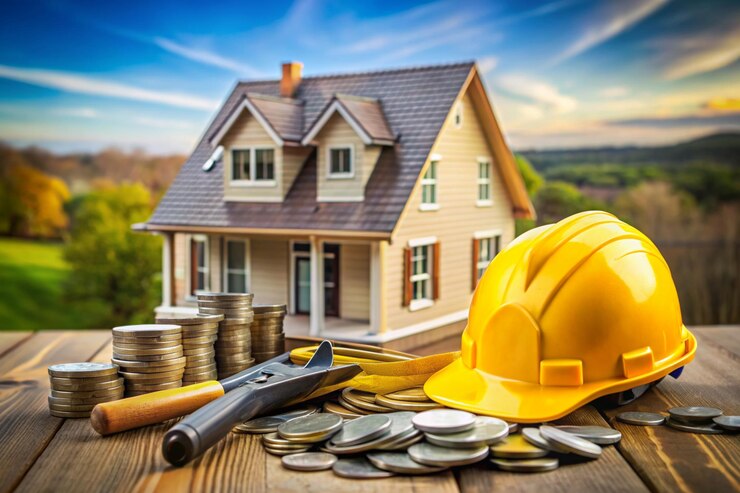It’s not possible to pay for the building of a new home with cash. You will need a Home construction loans in 2024.A regular mortgage loan is only for finished homes, but a construction loan can help you pay for the materials and labor to build a house from scratch.With a building loan, you can borrow money for the materials and labor you need to build a house. The loan terms are usually 12 to 18 months.

You can also buy the land where the house will be built with the loan money, or you can get a separate “lot loan” for that reason.There are variable interest rates on building loans, which means that the rates can change during the loan term.But in general, the rates on building loans are about 1% higher than the rates on mortgages.
How loans for building projects work:
With a construction loan, you generally don’t receive the full loan amount upfront. Instead, you receive the loan in installments to pay for the building work in stages.First, you create an estimated budget for the entire project. Then, you make at least the minimum down payment needed by the lender.
As the building project progresses, you’re able to draw down on the loan money in phases to cover associated costs. Each “draw” pays the builder for that finished stage of construction.Typically, the work is completed, then you make a loan withdrawal request says Gevurtz.
The lender sends an inspector out to examine the work and approve the request. Then, a part of the loan can be wired or transferred to your bank account.
Home construction loans in 2024 types:
A construction-to-permanent loan funds the construction costs as well as the finished home. It changes from an initial adjustable-rate construction loan to a fixed-rate, permanent mortgage loan once the work is complete
A construction-only loan is a short-term adjustable-rate loan used only to finish the building of your home. Once that happens, this loan either needs to be paid off in full or refinanced into a mortgage loan for permanent financing
An owner-builder loan is for homeowners who also want to act as the general contractor for their own project. “These loans can be less expensive and offer lower rates than the other two options. But bankers often see them as a very high risk, so they may be harder to obtain,” says Gevurtz. You generally have to be a professional builder to get one
As with a mortgage, you’ll want to explore all your financing choices, and compare offers from a few different lenders.The right type of construction loan for you will depend on your finances, your timeline, and who can give you the best interest rate for your situation.
Steps to get a building loan:
It can be more difficult to apply for a construction loan than a traditional mortgage.It will depend on your financial strength as a borrower, your plans and specs for the project, your project budget, and what you plan to do with the home once it’s finished says Robert Withers of M1 Capital Corp.
Each lender has its own application method and requirements. But in general, you’ll have to provide detailed details about your:
- Income
- Employer
- Credit (scores generally need to be above 720)
- Down payment (you likely need at least 10%)
- Builder/general worker
- Construction budget
Once the loan is approved, the loan will finally close through a title company as a mortgage loan would.Instead of getting a lump sum payout at closing, your borrowed funds are withdrawn upon request at each stage of the building project.You should select a construction loan lender based on their experience in construction financing. Shop around carefully suggests Withers.
He warns that finding and qualifying for a construction loan is particularly tricky these days due to the current economic downturn.To help you find the best deal on home construction financing, it may be worth seeking out an experienced and reputable broker to help you compare loan choices.
Construction loans vs. repair loans:
Construction loan funds can be used to pay for land, supplies, labor, and other costs linked to building a home.In this case, you’ll want to chase a “rehab loan” instead of a construction loan. The funds from a rehabilitation or renovation loan can cover the expenses involved with repairing or remodeling a current home.One popular remodeling loan is an FHA 203k rehab loan.

This [loan] allows you to borrow funds to purchase the home as well as pay for desired or needed repairs or renovations,says Paul Welden, head of The 203k Contractor Certification Program.FHA 203k loans cannot be used for new construction. And they can only be used on existing one- to four-unit properties that have been finished for a minimum of one year.
Welden adds that an FHA 203k loan requires a minimum of 3.5 percent down — which is quite a bit less than the 10 to 20 percent needed for a construction loan.Similar to construction loans, interest rates for the FHA 203k can be up to one percentage point higher than for a standard FHA mortgage loan.
Ways to fund renovations to an existing home:
Construction loans exist to fund new home construction. Homeowners who want to renovate an existing home have other choices, including:
Home equity loans: These “second” debts tap your current home’s value so you can use it on renovation projects. If you have a current mortgage already, you’ll make mortgage payments on both loans
Home equity lines of credit: This loan, also called a HELOC, taps your equity, but you decide when and how you take loan proceeds. You can draw a part of the HELOC, or all of it, at closing. You only pay interest on the amount you draw. You can also repay it, and then re-use the loan for additional projects within a set time frame.
Cash-out refinance loans: You can replace your current home loan with a new loan that’s big enough to finance your home building projects and pay off your existing mortgage. The “cash-out” refers to the equity you can take from your current home
All three of these choices require you to have equity built up in your home. The amount of money you can withdraw relies on your current equity and your home’s value.Unless you’re using a VA cash-out refinance you won’t be able to take 100 percent of your equity.
Construction loan FAQ:
Still have questions? Here are some quick answers, mainly provided by Gevurtz, to commonly asked questions about construction loans.
Can I get a building loan with no money down?
No, you cannot get a building loan with nothing down. A borrower must have cash or equity available for a building loan.
What are the criteria for a construction loan?
In addition to a specific plan and a qualified, approved borrower, one also needs money for a down payment and proof of the ability to repay the loan.
Like with a traditional mortgage, proof of your “ability to repay” will come in the form of credit reports, bank statements, W2s, and other papers verifying that you have sufficient, steady income to pay back the loan.
Is it easier to get a building loan than a mortgage?
Due to the risk involved with construction-loans, they are more difficult to get than a mortgage.
Do you pay on a construction loan while building?
When using a building loan, there is an interest-reserve fund built into the total amount borrowed which is used to make interest payments during the build.
What is the down payment on a building loan?
A minimum 10 percent down payment is usually recommended for a construction loan, though 20 percent is often preferable for lenders.
Which bank is best for building loans?
Private lenders and regional banks are often best for building loans. They are fit for taking a bigger risk and able to provide more innovative solutions.
What is the average building loan interest rate?
At the time of writing this, based on the lender, 4.5 percent is a typical interest rate for construction loans. That’s about one percent higher than a usual rate for mortgage loans during the same time period.
What is a good credit score to get a building loan?
You may need a higher credit score to get a building loan than to get most mortgage loans. A FICO score of 720 or higher is suggested for credit approval.
Is it cheaper to buy or build a house?
Usually, it is cheaper to build than to buy a home. That’s because you can create something exactly to your specifications and desires usually under cost than what you would pay for purchasing an existing home.

That said, it’s harder to apply for a construction loan than a mortgage. For many people, it’s simply more realistic to buy an existing home — especially for first time house buyers.
What is a draw schedule?
A draw schedule is the plan that outlines how you will send funds to the builder. When building a home, you don’t send the full loan disbursement to the builder before the project even starts. That’s asking for trouble. Rather, your lender will release funds slowly as each project milestone is finished. Foundation done? Some funds received. Framing done? More money to the builder. In this way, you limit losses in the case of a dishonest builder, or one that simply goes out of business during your project.
In this way, a building loan resembles a line of credit. A “draw” is taken a part at a time instead of in a lump sum.
How much are closing fees on a construction loan?
Construction loans require closing costs just like standard mortgage loans. Along with the processing and origination fees the mortgage company charges, you’d also have to pay for an appraisal, title insurance, and legal fees.
An advantage of construction-to-permanent funding is paying only one set of closing costs. With a construction-only loan, you’d pay closing costs twice: once on the building loan and once on the permanent loan.
Why are construction loan rates higher than normal mortgage rates?
With a standard mortgage, the lender can use the current home as collateral. With a building loan, the new house doesn’t exist yet so it can’t be used to secure the loan. The real estate plot you buy has value, but the loan amount will typically surpass the value of the real estate itself. Mortgage lenders represent this added risk through higher interest rates.
Can I apply for a building loan online?
Online banking has made getting a standard mortgage easier, but getting a construction loan generally requires more face-to-face contact with a loan officer. To get approved you’d need to share the unique information of your new home project.
What are today’s borrowing rates?
Interest rates stay near all-time lows for mortgages as well as other types of financing like construction loans.But, as always, rates change by person. So get a few quotes to see which loan can offer you the best deal.











2 thoughts on “Home construction loans in 2024”